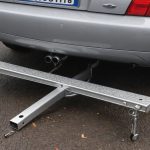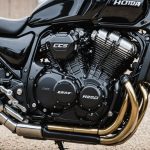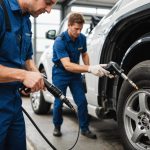Importance of Sealing and Waterproofing Convertible Roofs
Convertible roofs add charm and versatility to vehicles, but they also face unique challenges due to environmental exposure. Weather elements such as UV rays, rain, and dust can degrade the roof’s material over time, leading to leaks and potential damage. Regular convertible roof maintenance is vital to protect against these elements and ensure the optimum condition and performance of your vehicle.
Waterproofing significance cannot be overstated. By routinely sealing and waterproofing, you not only preserve the aesthetic of your convertible roof but also extend its vehicle longevity. Proper waterproofing prevents water infiltration, which can cause costly interior damages and degrade the fabric or vinyl material of the roof. Furthermore, it enhances the overall vehicle value and usability, keeping your convertible appealing and functional for years.
In the same genre : Key factors to choose the ideal tire pressure monitoring system for your uk vehicle
The process of maintaining a convertible roof involves selecting the right sealing products and applying them correctly. Investing the time and resources into this maintenance task is crucial. It safeguards against the need for expensive repairs or replacements, while ensuring your vehicle remains a reliable and enjoyable ride. Taking these preventive measures will surely yield long-term benefits for any convertible owner.
Selecting Appropriate Materials for Waterproofing
Choosing the right sealing materials and waterproofing products is crucial for maintaining your convertible roof. It’s important to match the product with the type of material your roof is made of, whether it’s fabric or vinyl.
In parallel : Maximizing performance: why ceramic brake pads are a game changer for british sports cars
Types of Sealing Solutions
There are various kinds of sealing solutions available, such as liquid, spray, and adhesive sealants. Each type serves different purposes, offering varying levels of protection. Liquid sealants are typically brushed on and are excellent for creating a complete barrier. Sprays are convenient for quick applications and ideal for touch-ups. Adhesives work well on seams for added protection.
Best Waterproofing Products on the Market
Top-rated waterproofing products often come from brands praised for durability and ease of application. Product reviews can guide you in selecting a sealant known for its long-lasting effects and reliability in harsh conditions.
Importance of Compatibility with Roof Materials
Ensuring product compatibility with your roof materials is essential. Certain sealants are formulated specifically for fabric roofs, while others are designed for vinyl. Failing to use compatible products could lead to ineffective sealing or even material damage. Always check the manufacturer’s recommendations and opt for products tailored for your specific roof type.
Step-by-Step Guide to Sealing and Waterproofing
Sealing and waterproofing your convertible roof enhances its longevity, and maintaining it by yourself is entirely feasible, provided you follow key waterproofing steps. Begin by preparing your roof: a clean surface ensures better seal adherence. Utilize a mild shampoo to remove dirt and grime, taking care to rinse thoroughly with water.
The sealing process involves applying an appropriate sealant. First, ensure the product suits your roof’s material, whether fabric or vinyl. Brush or spray the sealant evenly, coating the roof without oversaturating. This protective layer acts as a barrier against environmental exposure. Proper sealing is critical; miss any area and risks remain.
DIY maintenance can save costs, but precision matters. Follow these steps: start at one edge, gradually working across the surface using overlapping strokes. Allow each coat to dry as per the manufacturer’s instructions before adding another layer. This gradual build-up ensures robustness against rain and UV rays.
Finally, assess your work. Inspect your roof for missed spots, reapplying sealant if necessary. These effective waterproofing techniques secure your vehicle against potential weather damage, optimising vehicle longevity through straightforward, regular care.
Common Mistakes to Avoid
Maintaining your convertible roof requires careful attention to avoid common waterproofing pitfalls. Understanding these can prevent costly repairs and ensure vehicle longevity.
Overapplication of Products
Applying too much sealant is a frequent sealing error. This can cause unsightly build-up and uneven protection, diminishing the vehicle’s aesthetic appeal. Always follow manufacturer instructions for optimal coverage.
Ignoring Manufacturer Instructions
Disregarding specific product guidelines is a critical maintenance mistake. Each sealant is formulated with unique properties, necessitating adherence to precise application methods and drying times. Ignoring these can lead to ineffective waterproofing and potential roof damage.
Failing to Conduct Regular Inspections
Neglecting periodic inspection is another common oversight. Regular checks allow timely identification of damage, such as cracks or peeling in the protective layer. Missed inspections might lead to water infiltration and compromise the roof’s integrity over time.
Avoiding these waterproofing pitfalls can make a significant difference in your roof’s performance and longevity. By understanding and steering clear of these errors, you maintain your vehicle’s value and functionality. Regular inspections, adherence to guidelines, and moderated application are key strategies in effective convertible roof maintenance.
Preventative Maintenance Strategies
Establishing robust maintenance tips for your convertible requires diligence. Regular cleaning is essential to prolong seal integrity. A simple routine with a gentle shampoo, executed monthly, can prevent the buildup of dirt that weakens seals. This ensures your convertible roof maintenance is consistent and effective.
Conduct thorough roof inspection at regular intervals. Watch for signs of wear such as cracks or tears, particularly after extreme weather events. These checks can preempt issues, safeguarding your roof’s lifespan. Identify any potential damage early to avoid escalating repair costs.
Develop ongoing care strategies tailored to seasonal variations. In winter, remove accumulated snow promptly to alleviate excess weight that could strain your roof. During summer, protect against UV rays by parking in shaded areas when possible. These simple, seasonal adjustments contribute significantly to vehicle longevity.
Additionally, integrating leak-checking techniques aids in detecting any early signs of water ingress. After a downpour, inspect the interior for dampness. Identifying leaks promptly allows for swift corrective actions. Employ these preventative methods to ensure your vehicle value and usability remain high, providing a dependable driving experience year-round.
Frequently Asked Questions
Ensuring proper convertible roof care involves understanding maintenance intricacies and addressing user inquiries. Below, we address some common concerns with precise guidance:
How Often Should I Seal My Convertible Roof?
The frequency of sealing largely depends on climate conditions and usage patterns. In regions with harsh climates, sealing should typically be done every six to twelve months. This regularity maintains convertible roof care, protecting it from elements that degrade the material.
Can I Waterproof My Roof Myself?
Yes, DIY waterproofing is feasible with the right materials and instructions. Using appropriate sealing products can maintain roof integrity, offering an economical alternative to professional services. However, following each step accurately ensures effective outcomes, bolstering convertible roof care.
What Are the Signs of Roof Damage?
Indicators of potential issues include visible wear such as rips, fading, and leaks. Early detection through roof inspections prevents further damage. Feel for dampness after rain, and inspect the exterior for tears or unusual wear patterns, as these are telltale signs of a compromised roof. Identifying these early is key in prolonging roof care consistency.






